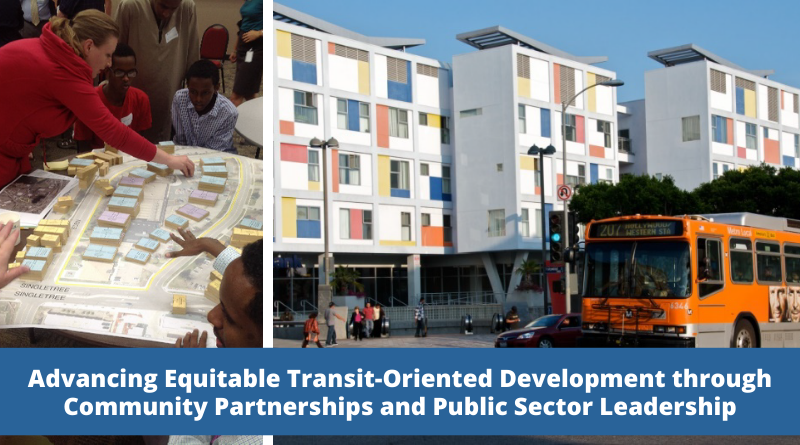Advancing Equitable Transit-Oriented Development through Community Partnerships and Public Sector Leadership. MZ Strategies, LLC. 2016.
The goal of equitable transit-oriented development (eTOD) is to promote and support communities where residents of all incomes, ages, and backgrounds can live and benefit from engaging in healthy and vibrant transit-friendly places. While TOD has the potential to disrupt, successful eTOD prevents displacement and ensures that current residents, businesses, artists, and other community members benefit from improvements. Achieving this goal requires inclusivity throughout the planning process and a strong affordable housing component. This white paper, produced by MZ Strategies, LLC with funding from the Ford Foundation, showcases eTOD efforts in four regions — Denver, Los Angeles, Minneapolis–Saint Paul, and Seattle.
In Denver, a coalition of many, varied stakeholders used a new funding tool to acquire land near transit for equitable development. The Los Angeles transit agency, Metro, has adopted policy calling for agency-owned land to be utilized for affordable housing. In the twin cities of Minneapolis–Saint Paul, a coalition of non-governmental organizations united to form the Central Corridor Funders Collaborative — which strategically invests resources in a set of comprehensive community building efforts. And in Washington State, the City of Seattle has worked to address workforce development and commercial stabilization in some of its most ethnically diverse transit-served communities.
The lessons learned through examining these efforts can be utilized by a host of stakeholders including transit providers, municipalities, regional planning organizations, nonprofits, community groups, and others looking to preserve and improve transit-rich places for all users. Among the major takeaways are:
- Transit agencies can lead the way by promoting equitable TOD through their joint development policies, incentives, and land disposition practices.
- Publicly-held lands are assets that can be leveraged to promote eTOD by engaging in higher-risk, change-invoking projects, providing affordable housing and demonstrating market feasibility.
- Displacement and gentrification affects not only housing but also small businesses, artists, community services, and other entities. Communities looking to minimize these outcomes should utilize resources from many sources to address these challenges, including local, regional and state economic development funds as these resources align with eTOD goals.
- Racial equity should be an explicit goal throughout the process and in any resulting projects.
- Collaboration takes time, and patience pays off. Advancing eTOD requires input from many stakeholders, including community and public agency partners. Learning from past success and failure is part of this process.
- Similarly, combine grasstops with grassroots. Non-governmental partners can help link local advocates with national institutions that can help advance work.
- Tracking accomplishments and measuring the impact of engagement help to communicate information about efforts. Identify appropriate performance measures, monitor effects over multiple years, and use this information to celebrate success as well as to inform and adjust policy and investment.
- Be aware of the history and culture of a place and understand how each is an essential part of the making of that place. Successful eTOD recognizes, preserves, and honors the history and diversity of the communities in which it occurs.
- High-quality transit forms the core of TOD. Which is to say that there should be access to frequent service that is well maintained and affordable.

